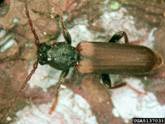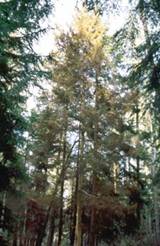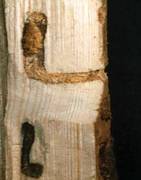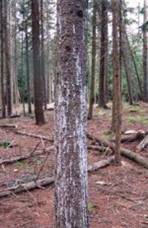DACF Home → Bureaus & Programs → Maine Forest Service → Forest Health & Monitoring → Invasive Threats to Maine's Forests and Tree → Brown Spruce Longhorn Beetle
BROWN SPRUCE LONGHORNED BEETLE
Tetropium fuscum
 The brown spruce longhorned beetle (Tetropium fuscum) is an invasive pest from Europe currently found in parts of Nova Scotia and New Brunswick Canada. This insect likely arrived in North America in solid wood packing material moved into the Port of Halifax. It can be spread in firewood, logs and other raw wood products.
The brown spruce longhorned beetle (Tetropium fuscum) is an invasive pest from Europe currently found in parts of Nova Scotia and New Brunswick Canada. This insect likely arrived in North America in solid wood packing material moved into the Port of Halifax. It can be spread in firewood, logs and other raw wood products.
Hosts - Spruce (main host), fir, pine and larch. In North America, only spruce has been found infested to date. Stressed (e.g. drought, root disease), dying, recently felled, or healthy trees can be attacked. Middle aged and mature spruce trees are preferred.
 Signs and Symptoms – Attacked trees may produce excessive white resin which flows down the length of the trunk.
Signs and Symptoms – Attacked trees may produce excessive white resin which flows down the length of the trunk.
Larvae feed on the inner bark and sapwood along the entire stem. However, the lower portions of the bole are the most heavily infested.
Larvae bore into the inner bark and excavate a network of irregular, 6 mm wide galleries, which become filled with tightly packed, fine-grained frass and short wood fibers. Much of the tree's inner bark can be destroyed by these wide, irregular and meandering larval galleries.
 Mature larvae bore "L-shaped" galleries within the sapwood. Larvae first bore into the sapwood to a depth of about 2 to 4 cm, then turn parallel to the trunk for another 3 cm to 4 cm.
Mature larvae bore "L-shaped" galleries within the sapwood. Larvae first bore into the sapwood to a depth of about 2 to 4 cm, then turn parallel to the trunk for another 3 cm to 4 cm.
Adults exit through oval or circular exit holes that are 4 mm to 6 mm in diameter, which may or may not be plugged with coarse sawdust. Beetles are 0.8 - 1.8 cm in length. Adults are not likely to be detected, and are very difficult to distinguish from native Tetropium.
Trees may be reinfested over subsequent years. Infested tree crowns exhibit progressive yellowing, browning and loss of needles. Once the tree has died, the remaining foliage changes to reddish-brown.
USDA APHIS Federal Order restricting movement of spruce logs and firewood from Canada: https://www.aphis.usda.gov/import_export/plants/plant_imports/federal_order/downloads/2011/DA-2011-28.pdf
For more information: http://www.nrcan.gc.ca/forests/fire-insects-disturbances/top-insects/13373 (Canadian Forest Service)
Photos: Canadian Forest Service, bugwood.org
Based on information from Canadian Forest Service and Canadian Food Inspection Agency
